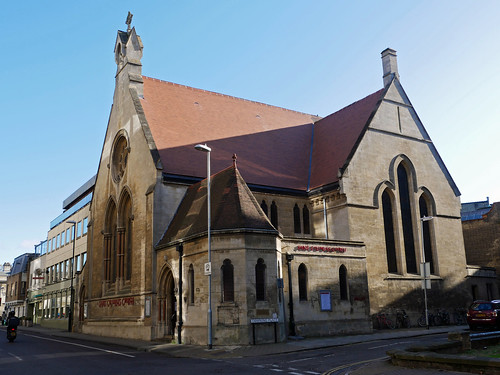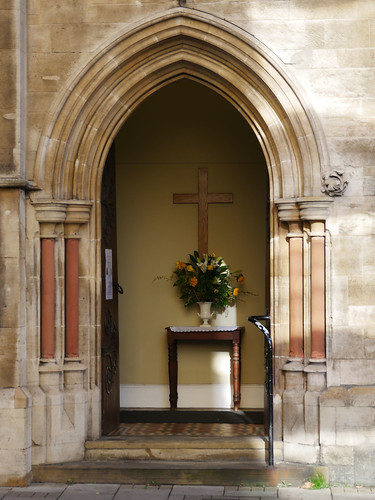The presence of Presbyterianism in Cambridge had dwindled through the eighteenth century. In the nineteenth century, many Scots and Irish Presbyterians began to move to the area to pursue careers in business, the professions and academia. This gave Presbyterianism in Cambridge a fresh impetus.
Until 1871, members of Cambridge colleges were required to attend worship in the Anglican college chapels. As this regulation was relaxed, more and more Presbyterians, mostly Scots, entered the University, and the demand for a congregation of the Presbyterian church in Cambridge grew. In 1879, the first congregation of the Presbyterian church in Cambridge met in the Guildhall. Work on the present church building began in 1890, and the new church was opened on 7 May 1891. In November 1893 the Presbytery approved the name of St Columba, ‘the presbyter-apostle of Iona’.Westminster College, a theological college of the Presbyterian Church of England came to Cambridge in 1899. This had a great influence over the life of St Columba’s, with many prominent theologians teaching at the college also becoming deeply involved in the life and preaching of the church. To this day, St Columba’s continues to benefit from the intellectual and spiritual work of those who teach at Westminster.
In 1972, the Presbyterian Church of England united with the Congregational Church in England and Wales to form the United Reformed Church, of which St Columba’s is now a part, with further unions in 1981 with the Churches of Christ and in 2000 with the Congregational Church of Scotland.
27 Comments CherryPie on Nov 28th 2017











Small but perfectly formed
It is interesting to note that until 1871, members of Cambridge colleges were required to attend worship in the Anglican college chapels. After all, each new college was set up to provide a community that was unique in some way. And why did it take so long to allow non-Anglican chapels to develop their own worship?
It is not unique to insist on worship in an Anglican chapel. All students of Winchester college are still required to attend Sunday services in the chapel, it is a condition of them studying there.
i am not too familiar with the various factions of Christianity, CP. i like the simple structure seen in the first shot, there is also a more modern visible to the left of it.
It all got a bit messy over the years and there is quite a lot of history around it.
To the left is indeed more modern. Opposite the modern building is very modern shopping centre.
I’m admiring those arches.
They are lovely aren’t they?
As congregations dwindled, it was sensible to combine the different Non-Conformist Churches
Better than losing churches altogether.
I’ve been learning a lot about familiar denominations, Cherry, in these last few weeks. While in Connecticut (New England!), I was astounded to see the Congregational churches founded by the Puritans…which same churches are now the United Church of Christ, one of the most welcoming denominations for the gay community right now, at least in the States.
There are several denominations in America that are unfamiliar to me.
We have a Mormon Church not far from where I live, that is one denomination that I do know about. The building looks quite out of place in its surroundings.
A Presbyterian saint? Hmmmm. At least they built their own church building rather than nicking one taken from the Catholics. But really ! Could they not have named it after some Scottish Presbyterian philanthropist rather than a Catholic Saint? There must be one around.
It’s not really nicking buildings it is far more complex than that. Henry VIII’s decision to cut himself off from the Church of Rome and declare himself head of the English Church had some disastrous consequences.
As to Presbyterian’s and their saints, I cannot say!
Elegant church dear Cheri!
thank you for sharing this angle of this unfamiliar angle of Churches as presbyterian was completely unknown to me ,i think i should learn it little more
It is quite an unusual type of church to see in England.
The architecture looks so different from what I am used to see in England, Cherrie
It is very different, that is why it caught my eye.
A saint’s a saint for all that.
Do you have any favourite Saints?
I do indeed. Saint Joan of Arc. Have blogged copiously on her.
Ah! Now I see your posts. I have not been on my computer much due to a tech problem that needed sorting.
One of my favourite Saints is Francis, I have been inspired by him since my childhood.
More recently I have also been inspired by Padre Pio and St Michael (not strictly a Saint but an Angel).
Noted and copied. Also like Mary Magdalene and St Catherine of Sienna. Goes without saying – Mary, mother of Jesus.
I came across one Presbyterian church in Kluang, Malaysia.
Just 2 weeks ago!
There aren’t very many of them in the UK.
I like the mix of the old and the new in the fist image.
There was lots of architectural styles along that street.
Interesting… Ref one of your other comments, I don’t think Columba was in the Catholic tradition!
Jesus’ teachings were meant to be disseminated around the world. In the far reaches of the UK Christian teachings arose separately before the Roman Church arrived and the original groups receded.
Columba was in the right location for this to be the case.